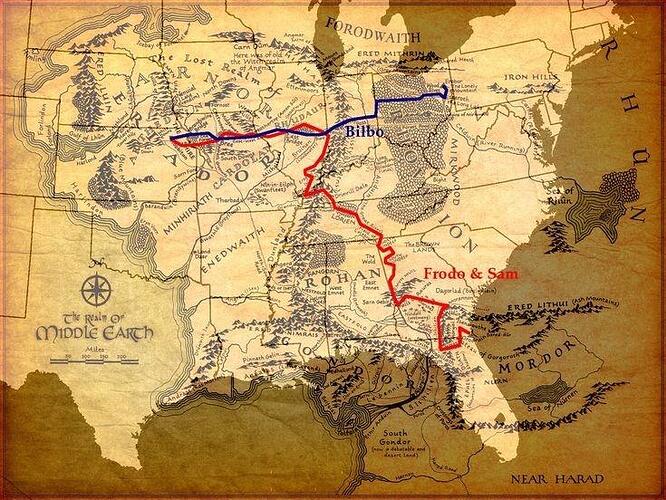Originally published at: A deep dive into Tolkien's iconic Middle-earth map | Boing Boing
…
PREVIOUSLY ON BOING BOING
There’s a bit of a fan tradition of superimposing Middle-Earth over our earth mostly to gain a sense of distance. …grimly amusing that Florida stands in for Mordor
(in the version for Europe, Mordor ends up in Bulgaria [shrug])
The rule of thumb for all fantasy maps seems to be “it’s basically the UK” because fantasy authors all seem to be secret Anglophiles. Or at least, they are “philic” for a happy go lucky grade-school sort of version of medieval UK-area history.
… if Middle Earth were in the Western Hemisphere, it would be mostly in Canada
Minas Tirith is about the same latitude as Toronto
“Hobbiton is assumed to be approx at latitude of Oxford. The green vertical lie is marked at distances of 100 miles (2cm to map scale). So you can roughly judge the climate and Fauna/Flora etc. Minas Tirith is about a latitude of Ravenna (but is 900 miles east of Hobbiton, more near Belgrade).” [link]
I just had the idea that British people have a strong affinity for maps because the UK is the best mapped country in the world. The Ordnance Survey has been producing increasingly detailed maps since the late 18th century, with the objective of suppressing rebellions and invasions. We are still taught how to read OS maps at school.
Then there is a long tradition of going abroad to invade places which also requires maps and charts. The Royal Navy was charting the world methodically in the 18th century.
Awesome, I grew up in Mirkwood.
I know this is just for scale, but the location of the shire in Southern Scotland rubs me the wrong way. Surely it should be in the Home Counties, or possibly the West Midlands.
What makes you think other countries don’t have equivalents of the OS? National mapping agency - Wikipedia
Heheh! I thought I was the only person who hated most fantasy maps for their inability to do basic geology. It’s a weird hang-up I know, but such a satisfying one.
Long ago when I was reading slush at Tor, I saved the maps from the fantasy submissions in a binder (which I regret not keeping for myself when I left). They were, for the most part, non-good. It’s pretty clear that forests and mountains and rivers exist only for plot reasons, not for geologic or environmental ones.
Yes I know that. The difference is that the British agencies have been operating for nearly 300 years.
But what about that is so special? That is only ever so slightly longer than e.g. Prussia and a good bit shorter than France.
I’ve been to Stranraer. I would not compare it to Hobbiton, unless hobbits like cold and damp.
I think that traditionally Hobbiton is supposed to be around Oxford.
The Institut national de l’information géographique et forestière (National Institute of Geographic and Forest Information), previously Institut géographique national (National Geographic Institute) or IGN is a French public state administrative establishment founded in 1940 to produce and maintain geographical information for France and its overseas departments and territories.
Britain’s mapping agency has its roots in military strategy: mapping the Scottish Highlands following rebellion in 1745.
Later, as the French Revolution rumbled on the other side of the English Channel, there were real fears the bloodshed might sweep across to our shores.
So the government ordered its defence ministry of the time – the Board of Ordnance – to begin a survey of England’s vulnerable southern coasts. Until then, maps had lacked the detail required for moving troops and planning campaigns.
It was an innovative young engineer called William Roy who was tasked with the initial small-scale military survey of Scotland.
Starting in 1747, it took eight years to complete what was known as the Great Map at a scale of 1:36 000
From the Ordnance Survey website history page
Come on - scrolling a little bit down the Wikipedia page where you got this quote will tell you:
And following the link:
From another page:
What? You don’t like your mountain ranges to have (multiple) 90 degree turns?




